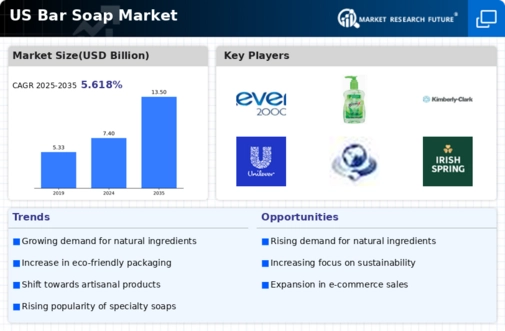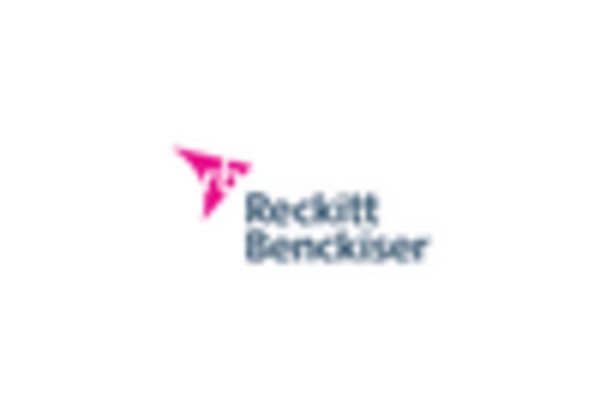Expansion of E-Commerce Platforms
The bar soap market is benefiting from the rapid expansion of e-commerce platforms, which have transformed the way consumers shop for personal care products. With the convenience of online shopping, consumers are increasingly turning to digital channels for their bar soap purchases. Recent reports indicate that e-commerce sales in the personal care sector are expected to grow by 20% annually, reflecting a shift in consumer behavior towards online retail. This trend is particularly pronounced among younger demographics, who favor the ease of access and variety offered by online platforms. Consequently, brands that invest in robust e-commerce strategies and optimize their online presence are likely to capture a larger share of the bar soap market. This shift not only enhances consumer accessibility but also encourages brands to innovate in their marketing and distribution approaches.
Rising Demand for Personal Hygiene Products
The bar soap market is witnessing an increase in demand for personal hygiene products, driven by a growing emphasis on health and wellness. Recent statistics indicate that the personal care segment, which includes bar soap, is projected to grow at a CAGR of 4.5% over the next five years. This growth is attributed to heightened consumer awareness regarding hygiene practices, particularly in urban areas. As individuals prioritize cleanliness and skin health, the demand for effective and gentle cleansing products is likely to rise. Consequently, manufacturers are focusing on developing formulations that cater to diverse skin types and preferences, thereby expanding their product offerings within the bar soap market. This trend not only reflects changing consumer behaviors but also presents opportunities for innovation in product development.
Influence of Social Media on Consumer Choices
The bar soap market is increasingly influenced by social media platforms, which play a pivotal role in shaping consumer preferences and purchasing decisions. With the rise of beauty influencers and lifestyle bloggers, consumers are exposed to a plethora of product recommendations and reviews. This digital landscape has led to a surge in interest for artisanal and niche brands, as consumers seek authenticity and unique experiences. Data suggests that nearly 70% of consumers are likely to purchase a product after seeing it endorsed on social media. As a result, brands that effectively leverage social media marketing strategies are likely to enhance their visibility and engagement within the bar soap market. This trend underscores the importance of digital presence and community building in driving sales and brand loyalty.
Emergence of Customizable Personal Care Products
The bar soap market is witnessing a growing trend towards customizable personal care products, as consumers seek tailored solutions that meet their specific needs. This shift is indicative of a broader movement towards personalization in the beauty and personal care sectors. Recent surveys reveal that over 50% of consumers express interest in products that can be customized to their preferences, whether in terms of fragrance, ingredients, or packaging. This demand for personalization is prompting manufacturers to explore innovative approaches, such as offering customizable bar soap options that allow consumers to select their desired attributes. As a result, brands that embrace this trend may enhance customer satisfaction and loyalty within the bar soap market. This evolution reflects a deeper understanding of consumer desires and the potential for differentiation in a competitive landscape.
Growing Consumer Preference for Eco-Friendly Products
The bar soap market is experiencing a notable shift as consumers increasingly favor eco-friendly products. This trend is driven by heightened awareness of environmental issues and a desire for sustainable living. According to recent data, approximately 60% of consumers in the US express a preference for products that utilize natural ingredients and sustainable packaging. This inclination towards eco-conscious choices is prompting manufacturers to innovate and reformulate their products, aligning with consumer values. As a result, brands that emphasize sustainability in their marketing strategies are likely to gain a competitive edge in the bar soap market. The industry's response to this demand may include the introduction of biodegradable packaging and the use of organic ingredients, which could further enhance consumer loyalty and market share.

















Leave a Comment